You can download the class 10 WBBSE Life Science book pdf from wbbsesolutions.guide
Chapter 4 Biology And Human Welfare Short Answer Questions
Question 1. What do you mean by biocontrol?
Answer: Using bacteria, viruses and some protozoa to control the pest naturally is called biocontrol.
Question 2. What are microphones?
Answer: Bacteria like Bacillus polymyxa, and Pseudomonas species of Aspergillus have the power to release phosphate from bound form and remain unable to be in dissolve states are called microphones.
Question 3. Name two free-living N, fixing bacteria.
Answer: Azotobactor and Bacillus polymyxa.
Read and Learn more about WBBSE Solutions for Class 10 Life Science And Environment
Question 4. Name two cyanobacteria.
Answer: Nostoc and Anabaena.
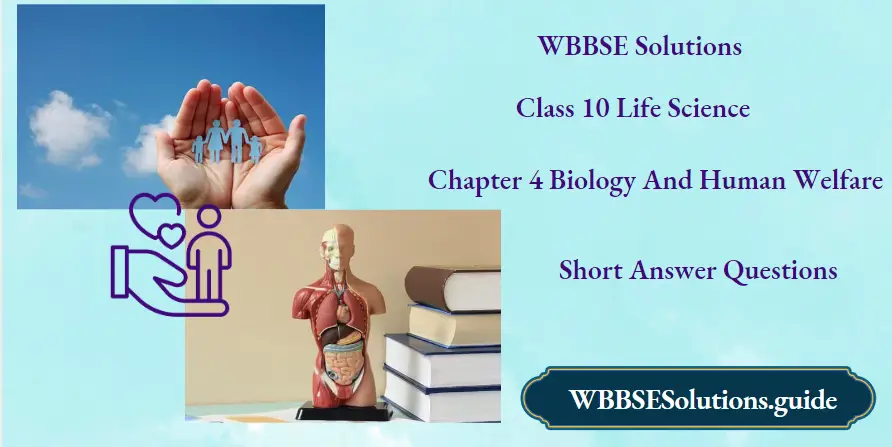
Question 5. What is mycorrhiza?
Answer: Symbiotic association of some fungi with roots of seed-bearing plants.
Question 6. Name one symbiotic bacterium.
Answer: Rhizobium leguminosarium.
Wbbse Class 10 Life Science Solutions
Question 7. Where from azotobactrine produced?
Answer: from the bacterium Azotobactor.
Question 8. What is meant by immunity?
Answer: The ability of the human body to resist almost all types of pathogenic microbes, toxins and other antigens.
Question 9. Name the parasites responsible for causing different types of human malaria.
Answer: Plasmodium vivex, Plasmodium falciparum, Plasmodium malariae, Plasmodium ovale.
Question 10. What are AIDS-related complexes?
Answer: AIDS-related complex is the most serious form of AIDS and is characterised by swollen lymph nodes, night sweats, fever and loss of weight.
Question 11. Name the pathogen of pneumonia.
Answer: Pneumonia is mainly caused by a diplococcus bacterium.
Question 12. What is allergy?
Answer: Allergy can be defined as an appropriate and excessive immune response of a person to some harmless common environmental substances, which come in contact with or enter the body.
Wbbse Class 10 Life Science Solutions
Question 13. Expand AIDS and HIV.
Answer: Acquired Immuno Deficiency Syndrome. Caused by a virus known as Human Immuno Deficiency Virus. There are three species of HIV which infect human beings: HIV-1, HIV-2 and HIV-3.
Question 14. Who is the “Father of Immunology”?
Answer: Louis Pasteur. He coined the term vaccination.
Question 15. What is interferon?
Answer: A small protein produced by vertebrate cells either naturally or in response to viral infection, which is capable of inhibiting viral multiplication.
Question 16. Which kind of Ig is most abundant in blood?
Answer: Ig G
Question 17. What is the chemical nature of antibodies?
Answer: Glycoprotein.
Question 18. What kind of immunity is achieved by vaccination?
Answer: Artificial active immunity.
Question 19. What is a booster dose of vaccination?
Answer: It is a subsequent dose of vaccine given after the primary dose to develop the effective and high level of antibody in blood for long-lasting immunity.
Question 20. Who discovered that the female anopheles mosquito is the vector of Plasmodium?
Answer: Sir Ronald Ross.
Question 21. Why male mosquitoes can not transmit malaria?
Answer: Because their mouth parts are not adopted for piercing human skin and bloodsucking.
Question 22. Who first coined the term antibiotics?
Answer: Selman Waksman in 1942.
Question 23. Name four products produced due to the fermentation of yeast.
Answer: Ethyl alcohol, Butyl alcohol, Acetaldehyde and phenyl ethanol.
Wbbse Class 10 Life Science Solutions
Question 24. What are probiotics?
Answer: When fermented milk products, idli, and dosa are taken in our body then they produce a special kind of microbes within the digestive system of human beings called probiotics.
Question 25. What is rennet?
Answer: From the stomach of the calf rennet is extracted which contains an enzyme renin used in cheese making.
Question 26. What is BOD?
Answer: Biological Oxygen Demand. The amount of biodegradable organics present in water is not measured directly but measured in terms of the requirement of oxygen of the microbial degradation process at 20°C, which is called Biological Oxygen Demand.
Question 27. What is biological control?
Answer: A natural method of pathogen and pest control in which bacteria, viruses and other insects like agents take part is called biological control.
Question 28. What is leg haemoglobin?
Answer: Within the root nodules of leguminous plants lies a haemoglobin-like compound called leg haemoglobin. It facilitates the diffusion of oxygen to the very rapidly respiring nitrogen-fixing symbiotic bacteria within the root nodule cells.
Question 29. Which type of blue-green algae is associated symbiotically with Azolla?
Answer: Anabena azolla.
Question 30. Which disease is known as “break-bone fever”?
Answer: Dengue.
Question 31. Expand OPV, BCG, DPT, WASH, MMR AND UNICEF.
Answer:
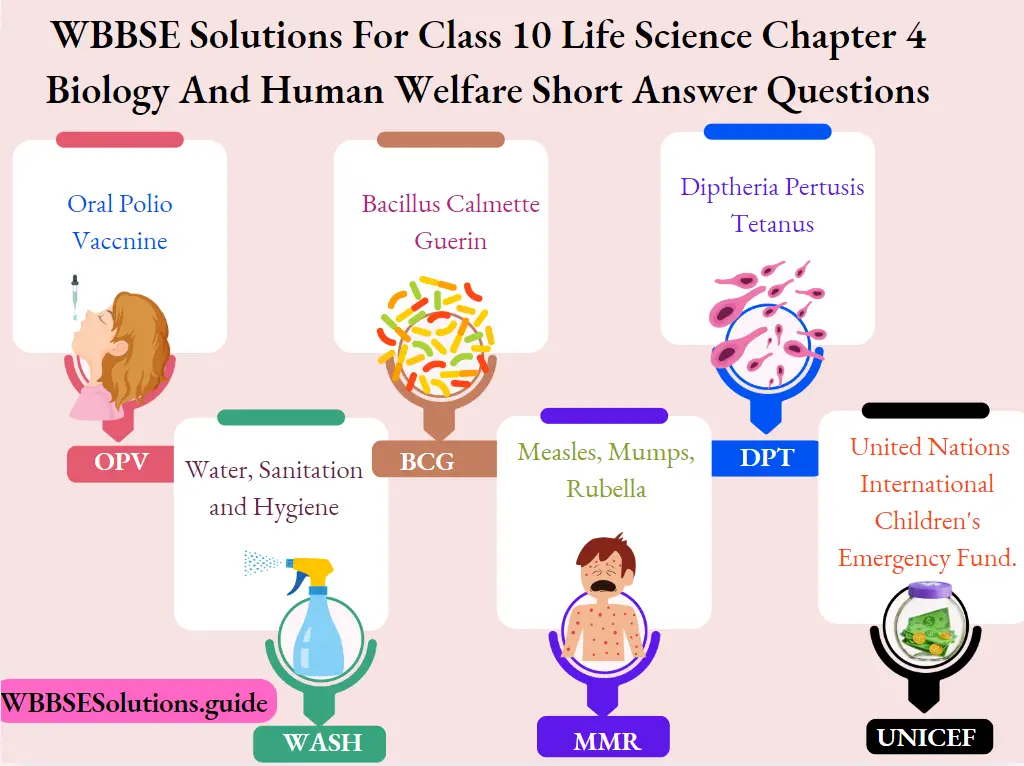
Question 32. What is vaccination? Give one example of the vaccine.
Answer: The process by which weak or dead pathogens are injected into the body to produce immunity against infectious disease by producing antibodies is called vaccination.
The principle of immunisation or vaccination is based on the property of ‘memory, of the immune system.
Question 33. What is immunisation? What do you mean by natural immunity and artificial immunity?
Answer:
Active immunity:
When a person is exposed to an antigen, the lymphocyte of his own body produces antibodies. This is called active immunity.
Passive immunity:
When pre-formed or ready-made antibodies are directly given to a person to protect the body, it is called passive immunity.
Question 34. Briefly describe the structure of the antibody.
Answer: Chemically antibody molecules are proteins in nature like globulins of blood plasma. So these molecules are also known as immunoglobulins (Ig). An immunoglobulin molecule is a ‘Y’ – shaped structure. Each molecule has specific antigen-binding sites by which it attaches with a specific antigen to inactivate it.
Wbbse Class 10 Life Science Solutions
Question 35. State the purpose of the WASH program.
Answer:
One objective:
The overall objective of UNICEF in the area of water, sanitation and hygiene (WASH) is to contribute to the realization of children’s rights to survival and development through the promotion of the sector and support to national programmes that increase equitable and sustainable access to, and use of, safe water and basis sanitation services, and promote improved hygiene.
Question 36. State two points of importance of biofertilizers.
Answer:
(1) The yield of plants can be increased by 15% – 35% by the application of biofertilizers.
(2) The inoculum which has to be applied in the field can be prepared by the farmers themselves.
Question 37. What are microphones?
Answer: Some bacteria like Bacillus polymyxa, Pseudomonas striata, and species of Aspergillus have the power to release phosphate from bound or immobile form and remain unable to be in dissolved states. These biofertilizers are called microphos.
Chapter 4 Biology And Human Welfare Descriptive Type Questions And Answers
Question 1. Define Immunity.
Answer:
Immunity:
Immunity means the body’s defence against disease. The body has numerous methods of preventing and curing infections. The defence system in our body works at two levels-
1. Local Defence System:
It tackles the germs in their possible points of entry. It includes a protective mechanical barrier, germ-killing secretion and germ-fighting WBC.
2. Immune System:
It deals with the germs after they have entered into the body tissue.
Immunity may be defined as the “Capacity of our body to deal with foreign substances that enter our body and to render them harmless”.
Wbbse Class 10 Life Science Solutions
Question 2. Classify immunity.
Answer:
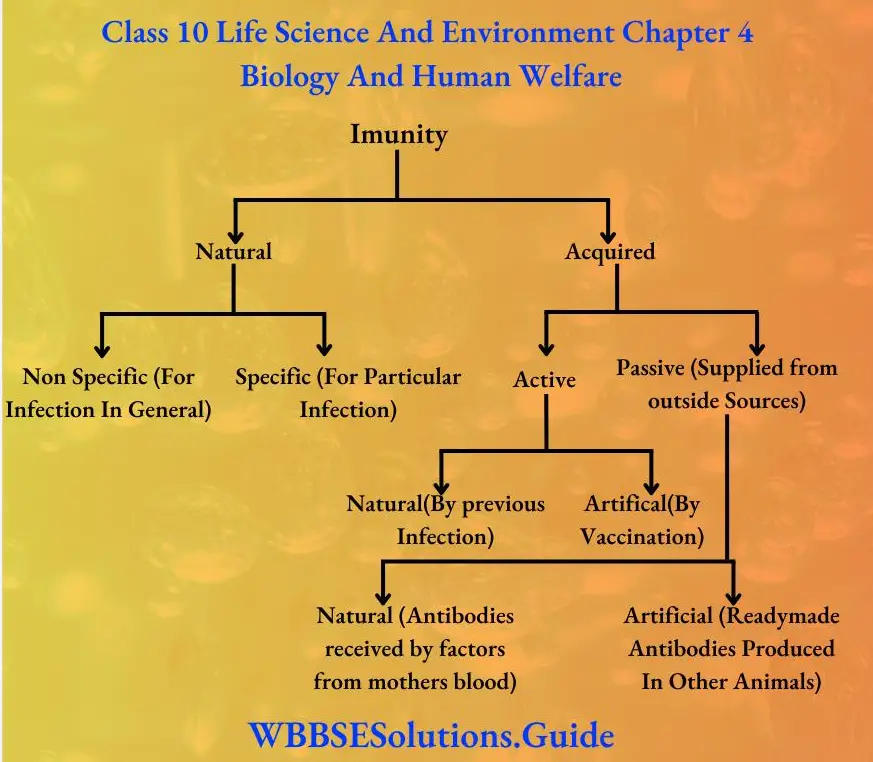
Question 3. Differentiate between Active and Passive Immunity.
Answer:
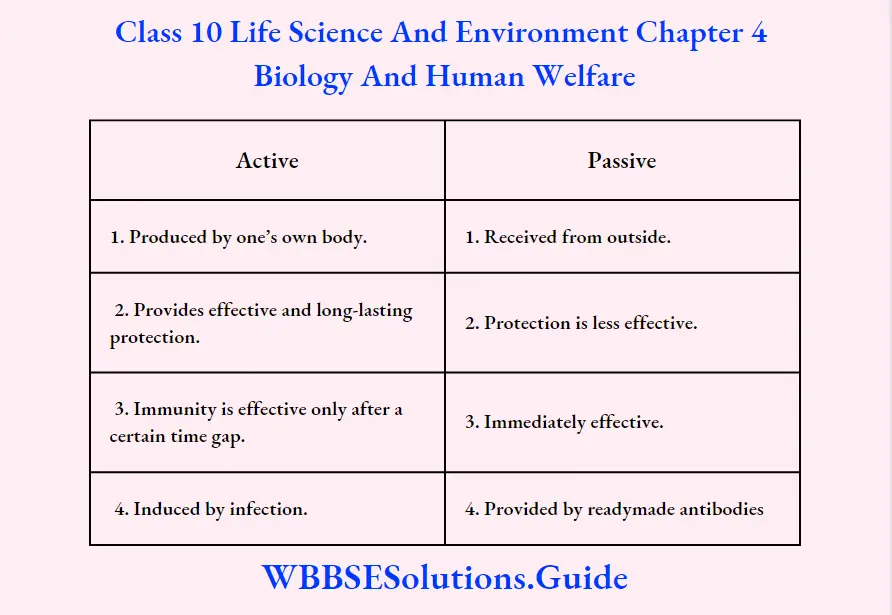
Question 4. Difference between antigen and antibody.
Answer:
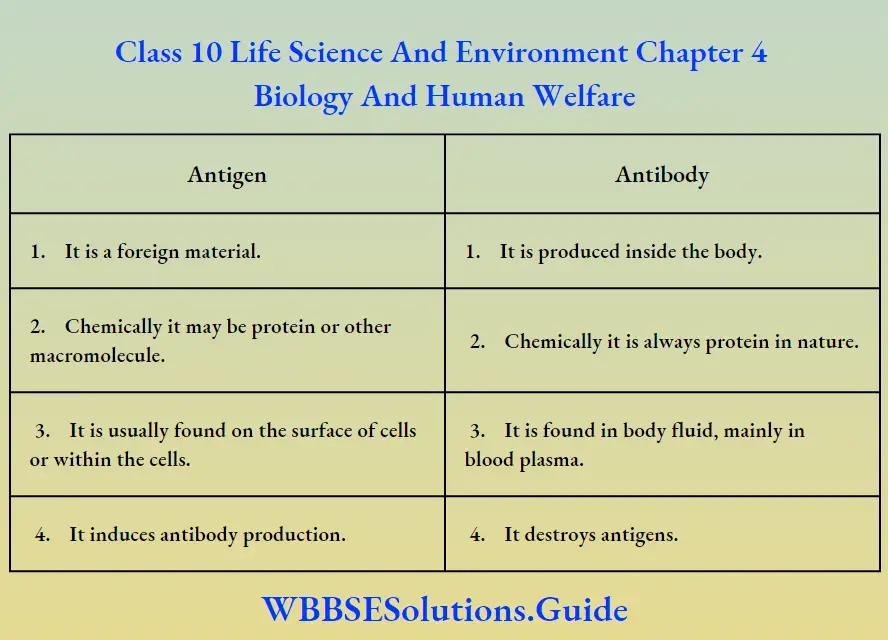
Question 5. What are antigens and antibodies?
Answer:
Antigen:
These are foreign substances which, on entering into the body evoke an immune response and are responsible for specific reactions with the antibodies. Since the antigens induce immune responses, they are also called immunogens.
Antigenes are usually found on the cell surface of pathogenic microbes. They enter into the body through food, beverages and air.
Antibodies:
These are special chemicals found in the blood which act against the germs. These are proteins and are produced on exposure to antigens. These are specific, which means that one kind of antibody acts against only one particular type of antigen.
Wbbse 10th Class Life Science Question Answer
Question 6. Draw the National Immunisation Schedule.
Answer:
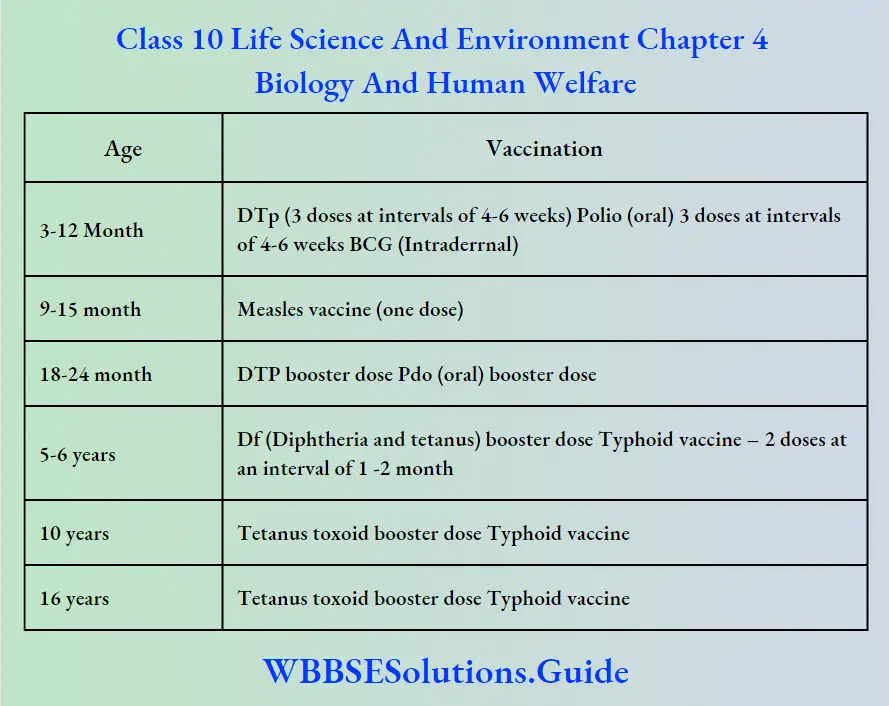
Question 7. How do microbes help us in our everyday life?
Answer:
Biocontrol agents:
The use of microbes to control pathogenic pests is termed as biological control.
(1) Bacteria:
(1) bacteria like Bacillus thuringiensis (Bt) can be utilised to control butterflies, caterpillar which act as microbial biocontrol agents. These Bt toxin genes when introduced into cotton plants, such plant get the power to resist the attack of insect pests.
(2) Ladybird beetles provided with red and black markings live by eating aphids.
(3) Bs toxin may be transferred to aquatic cyano-bacteria that kill the mosquito larva.
(2) Virus:
Baculovirus, a group of viruses, can destroy sawflies, mosquito larva stem borers, etc. The bacteriophage virus can destroy salmonella bacteria from water bodies.
(3) Protozoa:
Nosema sp. are protozoa microbes that directly penetrate the epithelium of insect gut and kill them. Metlasia grandis effectively control cotton ball weevil.
(4) Fungi :
The free-living fungus Trichoderma influences some plant pathogens as a biocontrol agent. Cordyceps is pathogenic to plant pathogenic nematodes. Use of microbes as biofertilizers: Microorganisms like bacteria, cyanobacteria and fungi when added to the soil, enrich the soil nutrients due to their biological activity and thereby increase the nitrogen content of the soil biofertilizer.
Free-living bacteria like Azotobactor and Clostridium and symbiotic bacteria like Rhizobium enrich the soil with nitrogen. Pseudomonas convert complex organic phosphate to simpler soluble inorganic phosphate which are easily utilized by plants. These biofertilizers are called microphos.
Rhizobium leguminosarium can fix nitrogen in peaplant. Rhizobium phaseoli can fix nitrogen in beans. Rhizonbium Japanicum can fix nitrogen in soybean.
Nostoc and Anabena are free-living cyanobacteria that act as biofertilizers in paddy fields.
Mycorrhiza :
The symbiotic association of some fungi with the roots of seed-bearing plants is called mycorrhiza. In this association, the fungi develop hyphae around the rood tip. They increase the life span of the roots of plants by providing food to them. They play an important role by absorbing selective elements.
Wbbse 10th Class Life Science Question Answer
Question 8. What are the concepts and components of WASH? Write its significance in eliminating disease burden.
Answer:
The concepts and components of WASH
WASH stands for water, sanitation and hygiene. Programm UNICEF (United Nations International Children Emergency Fund) has developed a global strategy to lift the standard of health of school children by providing them with adequate safe drinking water, proper sanitation and a sense of hygiene. This programme is popularly known as WASH. Besides providing water and sanitation facilities in school, children are made aware of the importance of washing hands before taking food. This can reduce waterborne disease.
According to UNICEF, there are three main components-
(1) To enable a child-friendly environment in the school.
(2) To improve hygiene behaviour among the students
(3) To build infrastructure for water supply and sanitation services.
Question 9. Define antigens. Write the chemical nature of antigens.
Answer:
Antigens
Antigens are foreign proteins which initiate immune response after entering the body and are capable of the production of specific antibodies from B-lymphocytes and interaction with the antibodies.
Chemical nature:
Antigens are large and complex molecules. Most often they are proteins. Nucleic acid, lipoprotein, glycoprotein and certain large polysaccharides may also act as antigens.
Question 10. What are epitopes? What are antibodies? Write the chemical nature of antibodies.
Answer:
Epitopes:
The specific portion of an antigen which is recognised by B and T- Lymphocytes of the immune system and to which an antibody binds is called epitopes. The epitopes are variously shaped, structurally distinct regions located on the surface of an antigen molecule. The sequence of amino acids in an epitope determines its shape.
Antibodies:
An antibody is a protein produced in the body in response to the entry of an antigen and is capable of reacting specifically with the same antigen to inactivate it. Thus antigens are antibody generators and antibodies are antigen destroyers.
Antibodies are also called immunoglobulins (Igs). The basic structure of the antibody molecule consists of four polypeptide chains. There are two long chains called heavy chains and two short chains called light chains. The four chains are held together by a disulphide bond forming a ‘Y’ shaped molecule. The Ig molecule has a constant part and a variable part. The variable part is located at the top of two arms of the Y and it contains the antigen binding site and forms an antigen-antibody complex. As a result of this antigen-containing micro-organisms are destroyed.
Question 11. Name some common diseases in humans. Mention their causative organism and symptoms.
Answer:
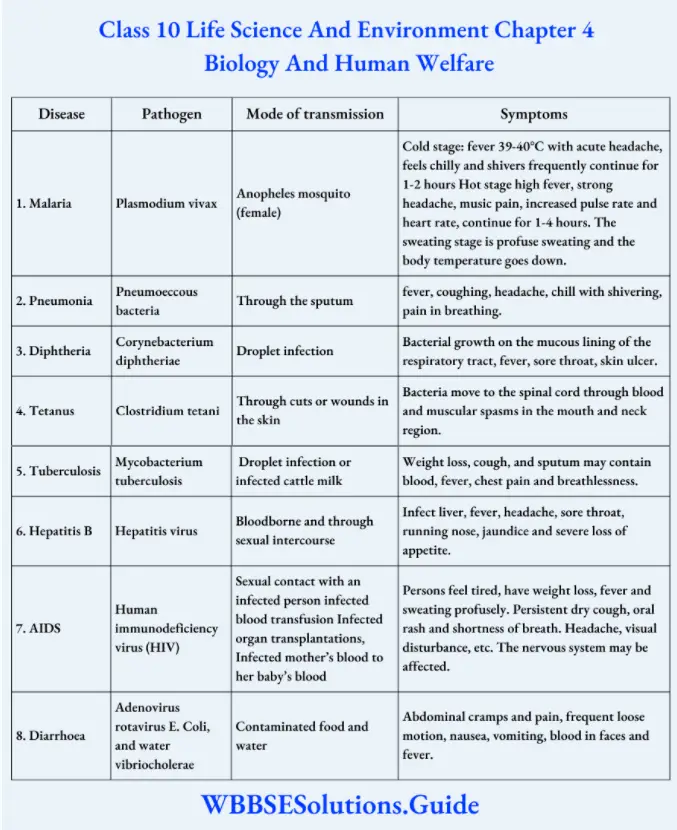
Question 12. What is vaccination? Name the different types of vaccines.
Answer:
Vaccination:
Vaccination is the introduction of any kind of dead or weakened germs into the body of a living being to develop immunity against the respective diseases.
Different types of vaccine:
A vaccine may be the preparation of any one of the following four categories:
(1) Killed germs:
As the TAB vaccine for typhoid
Salk’s vaccine for poliomyelitis
Rabies vaccine for dog bite
(2) Living weakened germs:
As the vaccine for measles BCG vaccine for tuberculosis.
(3) Living fully virulent germs:
As for smallpox. In this vaccination, a person is inoculated with cowpox virus which is very similar to smallpox virus.
(4) Toxoids:
As for diphtheria and tetanus. The toxoids are extracts of toxin secreted by bacteria and these poison are made harmless by the addition of formalin. Such extracts are called toxoids.
Question 13. Name the different types of antibodies with their location and functions.
Answer:
Based on their physical, chemical and physiological nature, antibodies are grouped into five categories –
IgA: Found in body secretion like saliva, tears, milk etc. It provides a primary defence mechanism against local inflexion.
IgD: Found mainly on the plasma membrane of lymphocytes. It acts as an antigen receptor. It is effective against toxins and allergens.
IgE: It is located on mast cells and basophils. It protects against parasitic worms.
IgM: It is found in blood and lymph. It is the largest immunoglobulin. It helps to body defence.
IgG: It is found in blood, lymph and intestine. It protects the body against bacteria and viruses by phagocytosis.
Question 14. Define Vaccine and Vaccination.
Answer:
Vaccine and Vaccination
A vaccine is a suspension of antigenic material used for the prevention of an infectious disease. It contains live but weakened micro-organisms or killed micro-organisms. Vaccination is the introduction of any kind of dead or weakened germs into the body of a living being to develop immunity against the disease.
Wbbse 10th Class Life Science Question Answer
Question 15. How microbes are related to human welfare?
Answer:
Microbes like bacteria and fungi grow in the media rich with nutrients forming calories.
They help in human welfare in the following ways
(1) In industrial food processing like preparation of dairy products, dough, single cell protein which serve as a source of modern food etc.
(2) Beverages obtained due to fermentation by yeast.
(3) Bacteria and fungi are used in the preparation of antibiotics. Antibiotics are chemical substances liberated from some microorganisms which inhibit the perfect growth and proper development of other microorganisms.
(4) Several organic acids are produced by the microbes as industrial products.
eg. acetic acid and lactic acid.
(5) Certain microbes are used in Sewage treatment. Wastewater and excrement are carried away in sewers.
Eg. Methanogen bacteria
(6) Microbes help in energy generation. Biogas is used as an excellent fuel produced due to the anaerobic breakdown of biomass by the use of methanobacterium.
Question 16. Write about the importance of microbes in agriculture.
Answer:
(1) Microbes as fertilizers:
Micro-organisms like bacteria, cyanobacteria and fungi when added to the soil, enrich the soil nutrients due to their biological activity and thereby increase the nitrogen content of the soil called biofertilizers.
(2) Microbes as biocontrol agents:
The use of bacteria, viruses and other insect-like agents to control pests and pathogens in the natural method is called biocontrol Bacillus thuringiensis (Bt), is a bacterial species that has the power to kill different insect pests.
Question 17. State the importance of lymphocytes.
Answer:
Role of Lymphocyte:
(1) Large lymphocytes are immature. During maturation large lymphocyte gradually loses cytoplasm and becomes a small lymphocyte which is matured.
(2) Small lymphocytes can be of two types – B-lymphocyte and T-lymphocyte. B- B-lymphocyte is produced and matured in bone marrow, whereas T-lymphocyte is produced in bone marrow but matured in the Thymus gland.
(3) When the B-lymphocyte is stimulated by an antigen, it produces a specific antibody. This is called humoral immunity.
(4) T-lymphocyte recognises the antigen or part of antigen. This is known as cellular immunity.
(5) T-lymphocyte stimulates B-lymphocyte to form antibodies.
question 18. Define the different types of immunity with examples.
Answer:
1. Inherited Immunity (Innate Immunity):
This immunity is present at the time of birth, e.g. Different types of WBC are present in the blood of a newborn body. These WBCs will protect the body against antigens as soon as it is exposed to air outside the mother’s body immediately after birth.
2. Acquired Immunity:
The type of immunity which is acquired by a person during his lifetime is called acquired immunity.
3. Active immunity:
When a person is exposed to an antigen, the lymphocyte of his own body produces antibodies. This is called active immunity.
4. Passive immunity:
When performed or readymade antibodies are directly given to a person to protect the body, it is called passive immunity.
Wbbse 10th Class Life Science Question Answer
Examples:
(1) Acquired active natural immunity- Once someone suffers from pox, generally pox virus cannot attack him any more.
(2) Acquired active artificial – Vaccination and stimulation of lymphocytes to produce antibodies, e.g. Injection of cholera vaccine.
(3) Acquired passive natural – Mother’s IgA enters the body of the baby along with milk; the mother’s IgG enters the foetus through the placenta.
(4) Acquired passive artificial-performed antibody (antivenom) from a rabbit or horse may be injected into a snake bite patient.
Question 19. How do vaccines work in our body? State the use of vaccine.
Answer:
Vaccines “teach” our body how to defend itself when germs, such as viruses or bacteria, etc. invade the body. The steps are –
(1) The body is exposed to a very small, very safe amount of virus or bacteria that have been weakened or killed.
(2) Our immune system then learns to recognize and attack the infection, if our body is exposed to that infection later in life.
(3) As a result, our body will not become ill or we may have a milder infection. This is a natural way to deal with infectious diseases.
Uses of vaccination:
A vaccinated person develops immunity against diseases like Mumps, Tuberculosis (TB), abies (causing hydrophobia), Polio, Cholera, Measles, Tetanus, Typhoid, Smallpox, and so on when vaccines for those diseases are injected into their body.
Question 20. State the historical development of vaccines.
Answer:
Historical perspective:
Edward Jenner and Vaccination :
For many centuries, smallpox devastated mankind. In modern times, we don’t have to worry about smallpox. We are grateful for the remarkable work of Edward Jenner. With the rapid advancement of vaccination, the historic origin of immunisation is often forgotten.
Edward Jenner (17 May 1749-26 January 1823) was a British physician and scientist who was a pioneer of smallpox vaccine, the world’s first vaccine. He is often called as “the father of Immunology”. It is said that “Jenner’s work saved more lives than the work of any other human.”
Jenner observed that milkmaids were generally immune to smallpox. Cowpox is a disease in cows, similar to smallpox, but much less virulent. Jenner noticed that cows suffering from cowpox form blisters from where pus comes out. While handling the cow, milkmaids received this pus from a cow. This cowpus protected the milkmaids from smallpox. Jenner collected this pus from cows and also from cowpox blisters on the hands of milkmaids. He then inoculated the material to different persons who developed immunity against smallpox and did not suffer from smallpox any more.
Jenner’s discovery was accepted and vaccination was recognised in 1840 by the British Government.
Question 21. Write a short note on nitrogen-fixing bacteria.
Answer:
Nitrogen-fixing bacteria
Symbiotic nitrogen-fixing bacteria: Hellriegel and Wilfarth (1888) showed that the leguminous plants with root nodules were able to increase the percentage of nitrogen in the soil. Within the root nodules reside a type of bacterium. He suggested that there lies a symbiotic relationship between the nodule bacteria and the host plant. That symbiotic bacterium was named Bacillus radicicola by Beijerinck (1888). Later on, it was renamed Rhizobium leguminosarium by Frank (1890).
The gram-negative, rod-shaped bacterium Rhizobium enters from the soil as infection threads into the roots of Leguminous plants, where due to the influence of certain substances like biotin or amino acid, enzymes, sugars and vitamins, may cause the root cells to divide forming root nodules. Certain growth substances like Indole Acetic Acid (IAA) secreted by the bacteria cause root hairs to curl.
Symbiotic nitrogen-fixing bacteria Rhizobium leguminosarium is residing in the root nodules of leguminous plants and converts nitrogen of air to soluble nitrates. Nitrates are used by host plants which results in increased growth and yield. With the death of host plants, root nodules release bacteria as well as nitrates into the soil whereby increases the fertility of the soil. Symbiotic bacteria Rhizobium fixes atmospheric nitrogen in the presence of a pigment called leghaemoglobin.
Within the root nodules of leguminous plants lies a haemoglobin-like compound called leghaemoglobin (LHb)- the only haemoglobin-like protein found to be present in higher plants. It facilitates the diffusion of oxygen (O2) to the very rapidly respiring nitrogen-fixing symbiotic bacteroids within the root nodule cells, thereby stimulating ATP production. The addition of phosphate fertiliser increases the efficiency of nitrogen fixation and in turn, increases crop yield.
Frankia, a nitrogen-fixing mycelial bacterium under Actinomycetes, is associated symbiotically with the root nodules of several non-leguminous plants Casuarina, Myrica, Rubus, Alnus, etc.
Question 22. State the importance of biofertilizers.
Answer:
Some points of importance of biofertilizers are stated as follows:
(1) The yield of plants can be increased by 15% – 35% by the application of biofertilizers.
(2) The inoculum which has to be applied in the field can be prepared by the farmers themselves.
(3) The soil texture was improved by the biofertilizers.
(4) In semi-arid conditions biofertilizers are also effective, giving a good result.
(5) They disallow pathogens to grow vigorously.
(6) Some vitamins and growth-promoting biochemicals can also be produced by
them.
Question 23. What is mycorrhiza? Explain the two types of mycorrhiza.
Answer:
(1) Mycorrhiza :
The symbiotic association of some fungi with the roots of seed-bearing plants is called mycorrhiza.
(2) Types of Mycorrhiza: Two types –
1. Ectotrophic mycorrhiza or Ectomycorrhiza :
In this case, the fungus lives outside the tissues of the root of Pine, Oak, Eucalyptus, Alunus, Betula, etc. The fungus replacing the normal root hairs of the plants forms a covering or mantle outside the roots of trees. This mantle increases the surface area of absorption, thereby increasing the uptake of water and mineral nutrients and in turn, increases plant vigour, growth and yield.
This mycorrhiza absorbs and stores nitrogen, phosphorus, potassium, and calcium in its fungal mantle. Simpler organic molecules are formed from complex organic molecules by them. They also convert insoluble organic compounds into soluble and easily absorbable forms. A network is formed when the fungal hyphae penetrate the intercellular spaces of the cortex of the root to form finally a net-like structure. This is called Hartig net.
2. Endotrophic mycorrhiza or Endomycorrhiza :
When a fungus lives inside the root cortex and does not form a mantle on the surface of the root, this mycorrhizal association is called endotrophic mycorrhiza. These associations are found in herbaceous species like orchids and some woody plants. Here fungus produces loosely interwoven hyphae, some of which penetrate the soil while others grow on the root cortex.
In the cortex, some hyphae grow in between the cortical cells, while some penetrate the cortical cells forming swollen vesicles or finely branched hyphal masses called arbuscles. This fungal association is called vesicular-arbuscular mycorrhiza (VAM). Mycorrhizal association is noted in the root of legumes, cereals, tobacco, soybean and many orchids like Vanilla, Neottia, etc.
Question 24. State the importance of mycorrhizas in plants.
Answer:
Importance of Mycorrhizas about plants:
(1) They increase the life span of the roots of plants by providing food to them.
(2) They increase the surface area of roots of host plants by mantle formation.
(3) Fungus spread their mycelia into the soil from where they absorb different kinds of nutrients causing increased growth of the plant.
(4) Mycorrhizas play an important role by absorbing selective elements like Ca, K, Fe, Br, Cl, S and N which move easily and also elements which do not move like Zn, Cl, P.
(5) Some of the mycorrhizas produce metabolites which can change the power of plants to develop roots from wood plant cuttings. They enhance better development of roots during vegetative propagation.
(6) The resistance power of plants also increases. They make less effect of pathogens and pests on host plant health so that they become free from illness.
Question 25. Define antigens and antibodies with examples.
Answer:
Antigen and Antibody:
The natural defence system of our body involves two substances
(1) antigen and
(2) antibody.
Antigen:
The foreign substances (pathogens & toxins), which on entering our body activate the body’s immune system to produce specific antibodies are called antigens. Antigens are also called attackers.
Examples of antigens:
(1) Antigens mainly include simple or conjugated proteins (glycoproteins, lipoproteins, nucleoproteins, etc.), present on the surfaces of viruses, bacteria, fungal spores, etc.
(2) Chemicals synthesized in the cells of pathogens may act as antigens.
(3) New proteins produced by cancer cells or virus-infected cells are antigenic.
(4) Toxic chemicals like snake venom and insect venom are also antigens.
Antibody:
The defensive protein molecule which is produced in the body in response to a specific antigen to inactivate it, is called an antibody.
Question 26. What is an immune response? Classify it.
Answer:
Immune response:
The formation of antibodies in response to a specific antigen in the body is known as the immune response. It is a complex process, which is discussed below.
Types of immune response:
Immune response is a combination of two types of responses-
(1) cell-mediated response and
(2) humoral response.
Cell-mediated response :
As soon as the antigen enters into the body, T- T-lymphocytes or T-cells quickly proliferate in the thymus (‘T’ here indicates thymus). T- cells are of different types, and perform different functions.
Question 27. State the different types of T-cells with their functions. State the different types of B-cells with their functions.
Answer:
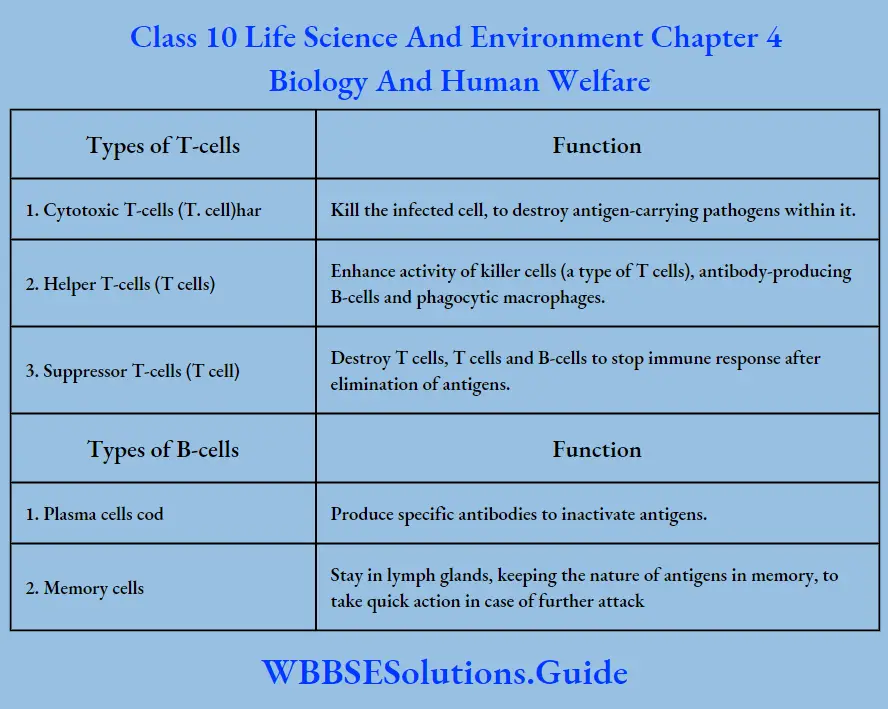
Question 28. How do microbes act as bio-control agents?
Answer:
Bio-control agents:
Several harmful organisms are spread in the environment from crop fields to water reservoirs. Scientists have found certain microbes which can act as natural enemies of those undesired organisms and reduce their population to a manageable level. These microbes are known as bio-control agents. There are some bacteria, viruses, fungi and protozoa that can be used as bio-control agents.
Bacteria as a bio-control agent:
Bacillus thuringiensis produces a poison, called BT toxin, which is used to control the larvae of moths, beetles and flies. Scientists have introduced some genetic materials of these bacteria in corn and cotton plants. As a result, BT toxin is synthesized in it, so that insect parasites cannot attack these plants.
Virus as a bio-control agent:
(1) Caudovirales is a group of phage viruses, which kill Salmonella (bacteria) from water bodies. This phage virus can be used to eliminate Salmonella from drinking water to protect us from severe diarrhoea.
(2) Nuclear Polyhedrosis Virus (NPV) or Cytoplasmic Polyhedrosis Virus (CPV) can kill larvae of moths and butterflies. These viruses are used to destroy some harmful insects like pine sawflies, gipsy moths, tussock moths, etc.
Protozoa as a bio-control agent:
(1) Nosema locusta is a protozoan microbe, which is used to control harmful grasshoppers.
(2) Mettasia grandis, another protozoa, effectively controls cotton ball weevils.
Fungus as a bio-control agent:
Beauveria bassiana is a fungus which can control mosquito populations effectively. It can be used in those areas where mosquitoes have developed resistance against chemical insecticides. It can also control termites, whiteflies and many other insects.
Question 29. How do microbes act as bio-fertilizers?
Answer:
Bio-fertilizers :
Certain microbes have a special ability to absorb atmospheric nitrogen and transform it into nitrates. After the death of these microorganisms, the trapped nitrogen gets mixed in the soil to increase its fertility. These microbes are now cultured and applied scientifically in crop fields to increase crop production. Therefore, these microbes are popularly known as bio-fertilizers.
Some of the bio-fertilizers are mentioned below.
Bacteria as bio-fertilizers:
(1) Rhizobium leguminosarum is.a symbiotic bacteria present in the root nodules of leguminous plants. These bacteria trap atmospheric nitrogen and convert it into nitrates. Ultimately this nitrate is transferred to the plant body as an essential nutrient.
(2) Some soil-living aerobic bacteria can absorb atmospheric nitrogen into the cells. After death, this nitrogen is released into the soil as nitrates and increases its fertility. Azotobacter sp., Azomonas sp., Derxia sp., Azospirillum sp., etc. are some examples.
(3) Among the anaerobic nitrogen-fixing bacteria, Clostridium, Chromatium, and Chlorobium are mentionable.
Cyanobacteria as bio-fertilizers:
Some cyanobacteria or blue-green algae can trap atmospheric nitrogen. These include Anabaena sp., Nostoc sp., Aulosira sp., Stigonema sp. Plectonema sp., etc. These blue-green algae are now cultured in the water of paddy fields. When these algae die and decompose, nitrates get absorbed in the soil and increase its fertility.
Mycorrhiza as bio-fertilizer:
Mycorrhiza is a symbiotic association between the roots of some plants and some fungi. In this association, the fungi develop hyphae (fine filaments of the fungal vegetative body) around the root tip or inside the cortex of roots. Mycorrhizal hyphae absorb phosphorus and nitrogenous nutrients from soil very efficiently. Besides this, it can remove harmful heavy metals like lead, mercury etc. from soil to reduce soil pollution. Mycorrhiza is formed in pines and some crop plants. The fungi involved in the formation of mycorrhiza are Boletus sp., Amanita sp., etc.
Question 30. Describe the different ways in which antibodies work.
Answer:
Antibodies work in different ways:
1. Neutralizing an Antigen:
The antibody can bind to an antigen, forming an antigen-antibody complex. This forms a shield around the antigen, preventing its normal function. This is how toxins from bacteria can be neutralized or how a cell can prevent a viral antigen from binding to a body cell thereby preventing infection.
2. Activating Complement:
Complement is a group of plasma proteins made by the liver that normally are inactive in the body. An antigen-antibody complex triggers a series of reactions that activate these proteins. Some of the activated proteins can cluster together from a pore or channel that inserts into a microbe’s plasma membrane. This lyses (ruptures) the cell.
3. Precipitating Antigens :
Sometimes the antibodies can bind to the same free antigen to cross-link them. This causes the antigen to precipitate out of the solution (a process called agglutination), making it easier for phagocytic cells to ingest them by phagocytosis.
4. Facilitating Phagocytosis:
The antigen-antibody complex signals phagocytic cells to attack. The complex also binds to the surface of macrophages to further facilitate phagocytosis.
Question 31. Write a short note on the experimental vaccine.
Answer:
Experimental Vaccine:
Several innovative vaccines are also in development and use:
(1) Dendrite cell vaccines combine dendritic cells with antigens to present the antigens to the body’s white blood cells, thus stimulating an immune reaction. These vaccines have shown some positive preliminary results for treating brain tumours.
(2) Recombinant vector-by combining the physiology of one microorganism and the DNA of the other, immunity can be created against diseases that have complex infection processes.
(3) DNA vaccine-in recent years a new type of vaccine called DNA vaccine, created from an infectious agent’s DNA, has been developed. It works by insertion (and expression, enhanced by the use of electroporation, triggering immune system recognition) of viral or bacterial DNA into human or animal cells.
(4) T-cell receptor peptide vaccines are under development for several diseases using models of Valley Fever, stomatitis, and atopic dermatitis. These peptides have been shown to modulate cytokine production and improve cell-mediated immunity.
Question 32. Write a short note on the comprehensive package for priority countries by UNICEF under the WASH programme.
Answer:
Comprehensive package for priority countries:
1. Promoting a balanced notional WASH programming framework:
UNICEF will encourage a three-pillar approach including the provision of water supply and sanitation services that are complemented by the promotion of improved hygiene behaviour and supported by an enabling environment.
2. Supporting intersectoral approaches:
Maximum child survival and development benefits are realized when hygiene, sanitation and water programmes are coordinated or integrated with other sectoral programmes including education, health and nutrition.
3. Providing catalytic and continuous support for scaling up sustainable WASH Programmes :
Targets will be met only when national service delivery programmes are significantly scaled up, and UNICEF will prioritize support activities that contribute to this end. However, increased coverage without improved sustainability is not true scaling-up, and UNICEF will actively work to identify and promote models to improve the sustainability of WASH services.
4. Supporting community management through effective decentralisation processes:
UNICEF will support measures that help create strong institutions at the intermediate level (municipal, district, province, etc.) since they are critical to supporting community-managed service provision, which is in turn essential to the sustained scaling up of WASH coverage.
5. Promoting safe and sustainable water supplies through improved water resources management:
UNICEF and its partners in the WASH sector have a responsibility to promote and implement measures to protect the freshwater resource base.
6. Focusing on sanitation, water quality and hygiene at the household level :
There is increasing evidence that a greater focus on the household level increases the effectiveness of sectoral programmes, especially in the areas of sanitation, water quality and hygiene promotion.
UNICEF will continue to promote affordable, safe household latrines; technology development in the area of household water treatment, and programmes that seek to improve household hygiene practices.
7. Addressing a child’s right to health and education through the provision of WASH in schools:
UNICEF is committed to ensuring that all children have access to high-quality water and sanitation services at school and the benefit of hygiene education. School-based WASH activities represent an opportunity to directly address a child’s right to both education and health.
Question 33. Write a short note on the package for all countries by UNICEF under the WASH programme.
Answer:
In all countries:
Strategies for all other countries where UNICEF works:
1. Advocacy and technical support for improving hygiene awareness and promoting behaviour change:
Including education, health, nutrition and young child survival and development programmes.
2. Technical support for water quality:
In the areas of water safety planning, water quality monitoring and quality mitigation programming.
3. Development of emergency preparedness plans for WASH:
Drawing on its competencies in emergency WASH programmes, UNICEF provides appropriate assistance to governments and other stakeholders in the development of national plans for WASH emergency preparedness.
4. Support to national monitoring for the achievement of MDG target 10:
UNICEF, with WHO, is the focal agency for global sector monitoring, and UNICEF also provides technical support for monitoring at the national level.
